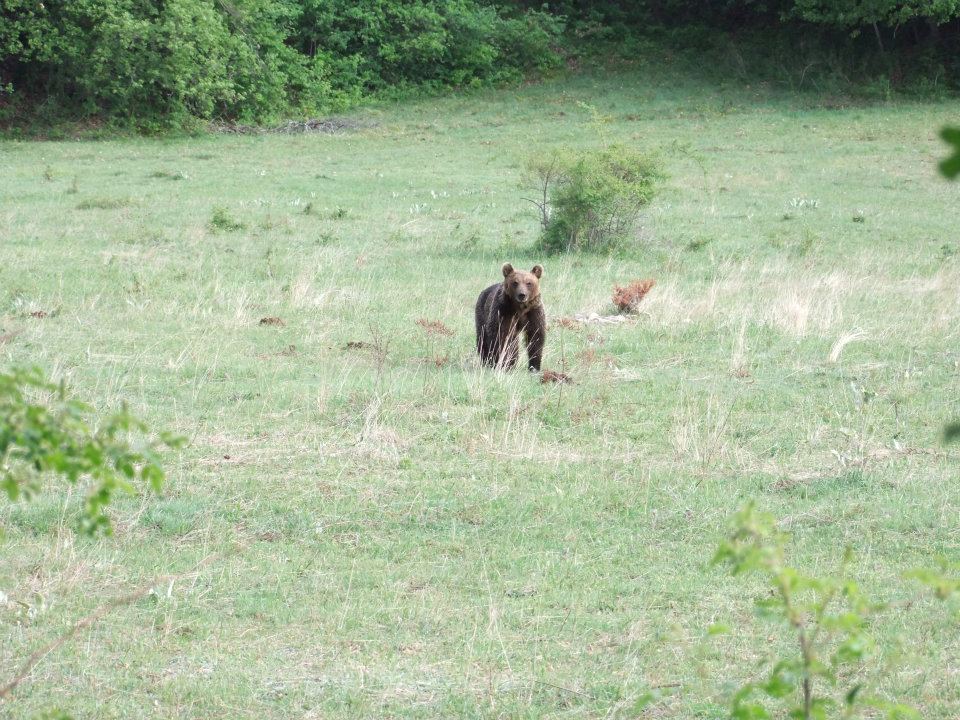The summary report of the operations of FWC counts (females with cubs) of the Marsican brown bear, made in the summer 2012 in the National Park of Abruzzo, Lazio and Molise is now available as part of the LIFE Arctos project (Initiative E3).
We have received the report because we participated as volunteers to operations on the ground: for many years the count operations have been supported by external volunteers (students, naturalists, bear lovers), a positive example of cooperation with the civil society to ensure a wider and punctual control of the territory and a more efficient monitoring of the species. Under the expert guidance of professionals, the use of volunteers allows, in certain occasions, to integrate and make up for the lack of funds and personnel systematically affecting our protected areas.
We thank the Park Scientific Service and the team of the University of Rome “La Sapienza”, in particular Dr. Elisabetta Tosoni, who coordinated all activities.
[hr style=dashed-line margin_top= margin_bottom=]
Cumulative count of family units of Marsican brown bear for estimating the productivity of the population: Summer 2012
P. Ciucci(1), E. Tosoni(1), L. Boitani(1), T. Altea(2), R. Latini(3), L. Sammarone(4), C. Sulli(3).
1 Department of Biology and Biotechnology “Charles Darwin”, University of Rome “La Sapienza”
2 State Forestry, Castel di Sangro Territorial Office for Biodiversity
3 Scientific Service, Authority of National Park of Abruzzo, Lazio and Molise
4 State Forestry Corps, Territorial Department for Environment of the National Park of Abruzzo, Lazio and Molise
Summary
As part of the E3 initiative of the Life Arctos Project, the cumulative count of female bears with cubs of the year (FWC) was made in the National Park of Abruzzo, Lazio and Molise (PNALM) also in 2012. Counts are organized according to a protocol standard, developed and used in previous phases of research (Ciucci et al., 2009, Tosoni 2010) and in the first year of the Life Arctos project (Ciucci et al., 2011). The Count of 2012, that will last until 2014 according to Life Arctos, is an important component of the demographic monitoring of the only Marsican bear population, a monitoring that use integrated methods, including non-invasive genetic sampling in non-consecutive years and estimates of productivity on an annual basis (carried out by our research group in collaboration with the other institutions involved since 2006).
In 2012, the simultaneous sessions saw the participation of 44-65 operators, and were divided up to 4 seasonal repetitions (August-September) in each sector, for a total of 888 hours of posting, mainly during the evening hours. In each session there were used from a minimum of 11 to a maximum of 23 sighting parcels, for a total of 20-27 lots. Overall, there were 124 sightings of bears (including sightings replications of the same individuals), of which 15 coinciding with FWC, with a yield of 1.7 FWC sightings/100 hours. From these sightings, based on space-temporal criteria for the conservative distinction of the different family units observed, a total of 3 FWC was calculated. In addition to simultaneous sessions, between April 1 and September 22, targeted and random observations were made in order to integrate the simultaneous counts, the identity and the uniqueness of the family groups previously counted, and increase the sighting frequency. In total, the targeted observations contributed with 44 sightings of FWC, leading to the integration of other 2 FWC unit consisting of a female with previous year’s cubs (FWY). The continuation of targeted observations until September 22 also allowed us to monitor the numerical composition of the family units counted during the summer (see below).
Ultimately, the integration of both strategies of observation led in 2012 to a total of 59 certain sightings of family units, corresponding to 5 FWC and 1 FWY, whose composition and dynamics are as follows:
- an adult female, the female identified as F05 according to her ear tags, with one cub of the year (code FWC 01-12); however, the presence of the cub has not been confirmed in all sightings since September. That makes us suppose that it probably died;
- an adult female, identified as the female FP01 (Gemma) according to her ear tags, with 2 cubs of the year (code units FWC 02-12); however, the presence of one of the two cubs has not been confirmed in all sightings since the end of August onwards. That makes us suppose that it probably died;
- an adult female with three cubs of the year (3.12 FWC code), with no tag and collar, observed with all her cubs until September;
- an adult female, identified as the female F01 or F02 according to her ear tags, with 3 cubs of the year (code FWC 04-12), all three cubs were observed until the last sighting in the end of August;
- an adult female with two cubs of the year (code 5.12 FWC), with no tag and collar, observed with only one cub from late August onwards;
- an adult female with three cubs of the previous year (code FWY 01-12) is likely to coincide with the only family unit counted in 2011 (code FWC 01-11). That certifies the survival of all her 3 cubs, then.
So, during 2012, it was counted a total of 11 cubs of the year within 5 family units, for an average litter size of 2 (± 1) cubs for female. However, at the time this report was written (September 25), 3 of the 11 cubs of the year previously counted were no longer sighted in any following observations of the same three family units: considering the close relationship between the cubs of this age and their mother, it is likely that these cubs have been lost from the population, with an apparent cubs’ mortality rate at the eighth month estimated at 27.3%. In 2012, between April and August, the three cubs of the previous year, belonging to the only family unit spotted last year, (1.11 FWC), were sighted, thus certifying their survival at 20 months and establishing the separation time from their mother.
The results obtained in 2012 contribute to a historical series of seven-year counts, according to which, thanks to the standardization of the method, it is possible to estimate not only the population size and productivity trends on an annual basis, but also the total number of adult females in it: from preliminary calculations, and in line with previous formal estimates of the population, in the period 2006 – 2010 the number of adult females in the population seems to fluctuate between 10 (2010) and 14 (2006 and 2007), with an apparent negative trend to be related with the high mortality of adult females recorded in recent years. The count results of the reproductive units in the next two years of the Life Arctos project will allow us to estimate the number of females in the population until 2012, and then better assess the demographic trends of this important segment of the population. Meanwhile, and similarly with what recommended in relation to the count of 2011, reaffirming the importance of an urgent implementation of a more effective pro-active strategy for the conservation of the population is necessary to reduce the impact of potential sources of risk; in this context, it must be discussed how imprudent is any optimistic interpretation on the relatively large number of family units reported in 2012 as an indication of a recovery of the population. Count operations themselves have in fact pointed out, also in 2012, as various disturbance and risk factors persist in the core area of the Marsican brown bear, including, in particular, the uncontrolled grazing of cows even on buckthorn scrubs of crucial importance for the bear, and the presence of stray dogs in the area. Count operations in 2012 were attended by the greatest number of volunteers ever. Therefore, in addition to contributing to the monitoring of the population, if properly planned and coordinated, the counts look like a useful and important integrative tool for the territory surveillance and control, as well as an important awareness and training moment of a large number of volunteers.
Thanks
For the realization in 2012 of operations counts of Marsican brown bear females with cubs of the year, we thank Anna Grassi (PNALM Monitoring Service) for the systematic and timely organizations of teams on the ground. Many external collaborators substantially contributed to the success of the count and deserve our warmest gratitude: the security staff of the Natural Reserve of Montagne della Duchessa, the staff of the Regional Parks of the Lazio Region (ARP), the members of Chiros Association, the staff of the CTA of Feltre. Special thanks to the many students of the course in Biological Sciences and master degree in Eco-biology at the University “La Sapienza” (M. Basile, F. Cattena, L. Chiaverini, C. Work hard, I. Fioramonti, F. Lasio, A. Liparoto, S. Mancinelli, D. Mastrodomenico, D. De Angelis, G. Senia), to the BBCD former students and technicians (M. Di Marco, O. Gallo, C. Gotti, M. Guerisoli, G . Grottolo Marasini, F. Paolella, N. Ranc, F. Quattrociocchi), and to all bear lovers and external local volunteers and PNALM’s ones that participated to different sessions, ensuring the full realization of the initiative and shot important videos and photos. It must be emphasized that all these students and volunteers worked for free and incurred themselves the costs of meals and lodging during their stay in PNALM. Last but not the least, special thanks to R. Mathieu and F. Savasta, N. Di Santo, S. Civitarese, M. Gentile, P. Dear, N. Lippa, M. Mazzola, S. Tribuzi.



